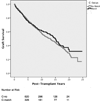Effect of human leukocyte antigen-C and -DQ matching on pediatric heart transplant graft survival
- PMID: 25128416
- PMCID: PMC4252914
- DOI: 10.1016/j.healun.2014.07.014
Effect of human leukocyte antigen-C and -DQ matching on pediatric heart transplant graft survival
Abstract
Background: A higher degree of human leukocyte antigen (HLA) matching at the A, B, and DR loci has been associated with improved long-term survival after pediatric heart transplantation in multiple International Society for Heart and Lung Transplantation registry reports. The aim of this study was to investigate the association of HLA matching at the C and DQ loci with pediatric graft survival.
Methods: The United Network of Organ Sharing database was queried for isolated heart transplants that occurred from 1988 to 2012 with a recipient age of 17 or younger and at least 1 postoperative follow-up encounter. When HLA matching at the C or DQ loci were analyzed, only transplants with complete typing of donor and recipient at the respective loci were included. Transplants were divided into patients with at least 1 match at the C locus (C-match) vs no match (C-no), and at least 1 match at the DQ (DQ-match) locus vs no match (DQ-no). Primary outcome was graft loss. Univariate analysis was performed with the log-rank test. Cox regression analysis was performed with the following patient factors included in the model: recipient age, ischemic time; recipient on ventilator, extracorporeal membrane oxygenation, ventricular assist device, or inotropes at transplant; recipient serum bilirubin and creatinine closest to transplant, ratio of donor weight to recipient weight, underlying cardiac diagnosis, crossmatch results, transplant year, and HLA matching at the A, B, and DR loci.
Results: Complete typing at the C locus occurred in 2,429 of 4,731 transplants (51%), and complete typing at the DQ locus occurred in 3,498 of 4,731 transplants (74%). Patient factors were similar in C-match and C-no, except for year of transplant (median year, 2007 [interquartile range, 1997-2010] vs year 2005 [interquartile range, 1996-2009], respectively; p = 0.03) and the degree of HLA matching at the A, B, and DR loci (high level of HLA matching in 11.9% vs 3%, respectively; p < 0.01). Matching at the C locus was not associated with a decreased risk of graft loss (median graft survival: 13.1 years [95% confidence interval {CI}, 11.5-14.8] in C-no vs 15.1 years [95% CI, 13.5-16.6) in C-match, p = 0.44 log-rank; hazard ratio, 0.93; 95% CI, 0.76-1.15; p = 0.52). DQ-match did not differ from DQ-no in any of the analyzed patient factors, except DQ-match was more likely to have high degree of matching at the A, B, and DR loci vs DQ-no (9.8% vs 3.2%, p < 0.01). Matching at the DQ locus was not associated with decreased risk of graft loss (median graft survival: DQ-no, 13.1 years [95% CI, 11.7-14.6) vs DQ-match, 13.0 years [95% CI, 11.4-14.6], p = 0.80, log-rank; hazard ratio, 0.95; 95% CI, 0.81-1.1; p = 0.51.
Conclusions: Complete typing at the C locus of both donor and recipient occurs less often then typing at the DQ locus. A higher degree of donor-recipient HLA matching at the C locus or the DQ locus appears not to confer any graft survival advantage.
Keywords: C locus; DQ locus; allograft survival; human leukocyte antigen typing; pediatric heart transplant.
Copyright © 2014 International Society for Heart and Lung Transplantation. Published by Elsevier Inc. All rights reserved.
Conflict of interest statement
Disclosures: No authors have relevant conflicts of interest to report.
Figures


Similar articles
-
Association of human leukocyte antigen donor-recipient matching and pediatric heart transplant graft survival.Circ Heart Fail. 2014 Jul;7(4):605-11. doi: 10.1161/CIRCHEARTFAILURE.113.001008. Epub 2014 May 15. Circ Heart Fail. 2014. PMID: 24833649 Free PMC article.
-
DQB1 antigen matching improves rejection-free survival in pediatric heart transplant recipients.J Heart Lung Transplant. 2024 May;43(5):816-825. doi: 10.1016/j.healun.2024.01.008. Epub 2024 Jan 15. J Heart Lung Transplant. 2024. PMID: 38232791
-
The influence of human leukocyte antigen matching on outcomes in pediatric heart transplantation.Pediatr Cardiol. 2014 Aug;35(6):1020-3. doi: 10.1007/s00246-014-0890-x. Epub 2014 Apr 23. Pediatr Cardiol. 2014. PMID: 24756223
-
Human leukocyte antigen matching in organ transplantation: what we know and how can we make it better (Revisiting the past, improving the future).Curr Opin Organ Transplant. 2018 Aug;23(4):470-476. doi: 10.1097/MOT.0000000000000538. Curr Opin Organ Transplant. 2018. PMID: 29750676 Review.
-
HLA compatibility and organ transplant survival. Collaborative Transplant Study.Rev Immunogenet. 1999;1(3):334-42. Rev Immunogenet. 1999. PMID: 11256424 Review.
Cited by
-
HLA and lung transplantation.Front Med. 2019 Jun;13(3):298-313. doi: 10.1007/s11684-018-0636-x. Epub 2019 Jun 11. Front Med. 2019. PMID: 29974325 Review.
-
Validation of a Simple Score to Determine Risk of Early Rejection After Pediatric Heart Transplantation.JACC Heart Fail. 2015 Sep;3(9):670-6. doi: 10.1016/j.jchf.2015.04.014. JACC Heart Fail. 2015. PMID: 26362445 Free PMC article.
References
-
- Opelz G, Wujciak T. The influence of HLA compatibility on graft survival after heart transplantation. The Collaborative Transplant Study. N Engl J Med. 1994 Mar 24;330(12):816–819. - PubMed
-
- Opelz G, Wujciak T, Dohler B, Scherer S, Mytilineos J. HLA compatibility and organ transplant survival. Collaborative Transplant Study. Rev Immunogenet. 1999;1(3):334–342. - PubMed
-
- Kilic A, Weiss ES, Allen JG, et al. Simple score to assess the risk of rejection after orthotopic heart transplantation. Circulation. 2012 Jun 19;125(24):3013–3021. - PubMed
-
- Kaczmarek I, Deutsch MA, Rohrer ME, et al. HLA-DR matching improves survival after heart transplantation: is it time to change allocation policies? J Heart Lung Transplant. 2006 Sep;25(9):1057–1062. - PubMed
-
- Dipchand AI, Kirk R, Edwards LB, et al. The registry of the international society for heart and lung transplantation: sixteenth official pediatric heart transplantation report-2013; focus theme: age. J Heart Lung Transplant. 2013 Oct;32(10):979–988. - PubMed
Publication types
MeSH terms
Substances
Grants and funding
LinkOut - more resources
Full Text Sources
Other Literature Sources
Medical
Research Materials

